The Wii U and Windows 8: Twinsies?
On the surface (no pun intended), Microsoft and Nintendo don’t have a lot in common. One’s a giant corporation that makes video game systems, and the other’s a…
Oh, nevermind.
The two companies, rivals in the gaming sphere, aren’t actually all that dissimilar. Sure, they have different mascots and different color schemes, but the two organizations share more qualities than they’d like to admit. And this fall, the overlap couldn’t be clearer with the mutually awkward releases of the Wii U and Window 8.
W is for Wide mass-market appeal
Let’s start with the high-level stuff: both the Wii U and Windows 8 are intended to reenzergize flagging interest in their core brands. For Nintendo, the Wii was a huge sales success, but one that lost momentum among hardcore gamers rather quickly. After the release of the biggest must-have games (Super Mario Galaxy, Super Smash Bros. Brawl, Dragonball X-3 Final Showdown Omega), the system simply wasn’t attracting love from developers and, consequentially, players. The Wii still sold hardware, sure, but it was mostly acting as a vessel for middle aged folk to try out Wii Sports, Wii Fit, and “that whole Netflix streaming thing.”
For Windows, it’s pretty much the same story. Windows 7 was universally hailed as the best version of the OS ever released, but that’s kind of like saying a plastic tumbler is the best new vessel for holding water ever released. It’s boring. There’s a desktop, a start menu… and that’s about it. They worked really well, but there was no pizzazz. So after the initial gleeful cheers of “death to Vista, viva la Windows 7!” calmed down, everyone was left with a functional, yet uninspiring, home computing environment.
Both W systems are intended to shake things up by being radically different from their predecessors. The names are the same, but the core functionality of both are almost unrecognizable from the previous iterations. And none is more obvious at first glance than the forced focus on touch as an input method.
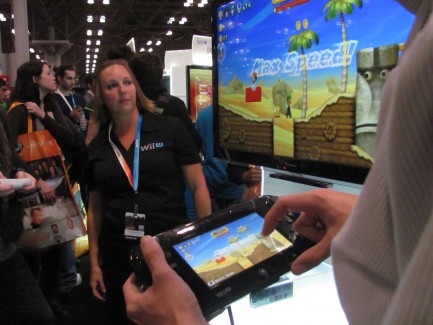
Pay no attention to the buttons on your controller. Just tap your touch screen in the most manic manner possible! Are you having fun yet?
W is for Warm to the touch
If you haven’t been paying attention lately, you might not realize that touch devices are all the rage. It stated with smartphones, but quickly spread to tablets, kiosks, and yes, the Playstation Vita. Nintendo and Microsoft were a little late to the party, but they’ve decided to make up for lost time by doubling down on the value of touch as an input medium.
For the Wii U, that means a capacitive controller that openly invites gamers to interact directly with it. Some titles are specifically designed for touch to be the primary control scheme, but most will forgo fingers-only navigation in lieu of UI enhancements and optional secondary actions (inventory management, mapping, etc.) For Windows 8, touch means an operating system that was designed from the ground up to work easily on tablets and touch-enabled monitors. While it’s not technically required in Windows 8, it is at once obvious from the layout of the new Start Screen that Microsoft wants you to at least try the tactile experience. You know, fool around a little before getting to the serious stuff.
An important point of distinction: the Wii U and Windows 8 are both indirect admissions that motion controls failed. Yes, the new Nintendo console and MS OS technically support legacy motion control (Wii controllers, for Wii U; Kinect for PC, for PC), but the huge focus on touch as an input method essentially overwrites both companies’ previous mantras about a future of motion controlled computing paradise. Microsoft’s release of SmartGlass for Xbox, which allows people to use touch devices as controllers for their consoles, is the nail in the coffin for Kinect. Who’s going to buy a $130+ camera when the cell phone they already own does a better job at navigating the Xbox’s various games and apps?
W is for Waging preemptive War
Finally, both the Wii U and Windows 8 are being scheduled aggressively to get ahead of the competition. On the Japanese front, Nintendo is hoping that, once again, getting its console into homes before the new series of Xbox/Playstation/Ouya/Steambox exist will result in greater long-term market share. It worked for the Wii, so it’s not an unreasonable wager. MS, Sony, Valve, and other gaming giants haven’t released any details about their plans for 2013/2014 consoles, but when they do, they’ll have to come out of the gates with something that’s demonstrably better than Wii U. That’s not an easy proposition, since Nintendo’s had almost two years to tout their new device.
On the software front, Microsoft is keen to have the first say in the cross-generational battle with Apple and its Macintosh computing environment. Few operating systems were as similar as Windows 7 and Mac OSX, so Windows 8 is being positioned early to set expectations going forward. If Apple had beaten Microsoft to the punch with a new operating system (Mountain Lion doesn’t really count), Bill Gates’ group would be forced to either one-up Mac’s improvements or produce excuses for avoiding them. Now that Microsoft has landed the first punch, it’s Apple that will be forced to play defense, which is precisely what Windows wants.
W is for Will it Work?
Windows 8 and Wii U are both large gambits for their respective producers, especially considering how wildly divergent they are from their respective, highly successful predecessors. With an emphasis on interactivity, social features, and touch, these systems are going all-in on what MS and Nintendo believe is the future of user experience.
That said, it’s now their competitions’ game to lose. If Sony, Apple, and the like follow suit, it’s possible Wii U and Windows 8 will be perceived as forward-thinking, with the “other guys” copying features and functionality. But those same competitors could also take a wholly different path, one that could leave Nintendo and Microsoft looking like your old, out of touch uncles thatjust don’t get it anymore. For example… remember Nintendo 64DD or Games for Windows Live?
Exactly.

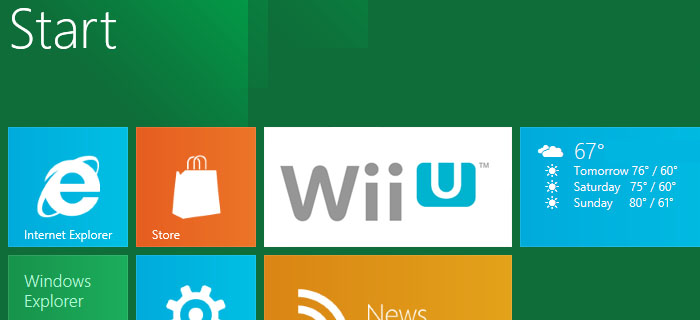
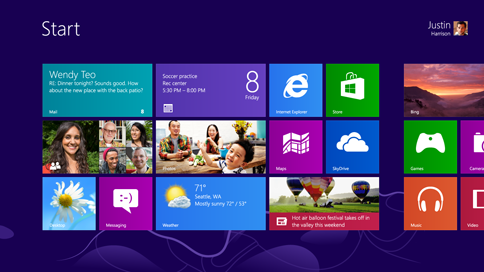

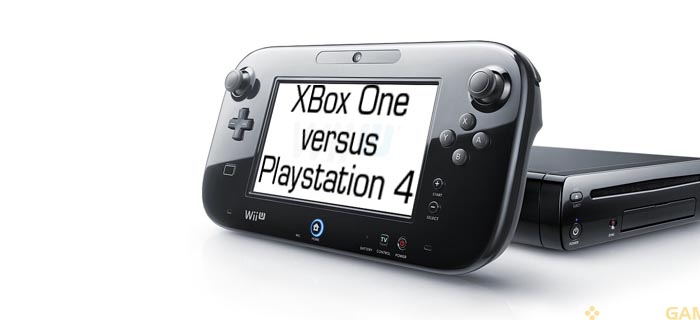



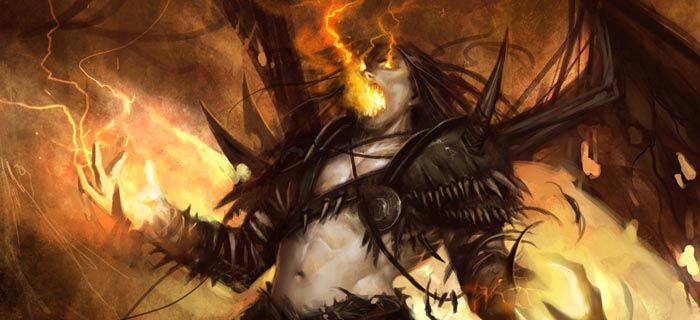
Very interesting article! I’ve got to point this out though, I think it’s unfair to say Nintendo were “a little late to the party” with touch screen devices, when they actually launched the first globally successful touch screen device with the DS in 2004, back when we were all jealous of people with Motorola RAZR clamshell phones!
Needless gripe from a touchy fanboy ;) this was a great read.
Ah yes how could I forget?
Wing, I love you man, but what the hell are you smokin?
“Uninspired”. “Boring.”??
I don’t want ‘inspiration from my god damn desktop operating system. I want it to get the living heck out of the way so I can get on with my day.
I sure as hell don’t want to be ‘interested’ or entertained by my O/S. Windows ME was interesting as you would care to like, what with the fantastic adventure in technical accomplishment needed to get anything to work.
I want my O/S to GET OUT OF THE WAY. The more boring and uninspiring it is, the better. The ideal O/S is the one I forget I’m using almost at once – Winodws 7 and XPSP3 did that pretty well.
Windows 8 is an exciting adventure of “whether someone who has been using dekstop operating systems for over 20 years can ever figure out how to run his word processor/” FUN TIMES.
Anyone who says differently just isn’t production or gaming oriented, simple as that. And so their opinion is irrelevant. Good luck MS, chasing the market of people who don’t care about/use computers.
Well, I don’t really understand how the OS gets in your way. If you populate the Start Screen with the things you’d be running off your desktop/start menu anyway, how is it different? The reality is that 90% of the actual “desktop” space in previous OS just goes to waste. You can fill it with icons and shortcuts, but then you’d basically have an uglier start screen.
Most of the other changes to Win8 are for productivity. Faster everything, more control of the Task Manager. Better file transfer interface. More shortcuts for power users. I don’t really see any of the changes getting in the way of that.
The start menu was a simple, functional interface. It wasn’t perfect, but a giant screen that takes over my desktop and dumps everything into the broad category of ‘apps’ and requires me to spend ages configuring it so it stops getting in my way is definitely in my way. I shouldn’t have to 3rd party mod my O/S just to make it usable. I can’t mod it on my client’s computers.
Further, they have hidden core system functionality even further down than Windows 7, changed shortcuts and layouts and locations arbitrarily. Why do power users have to relearn the O/S each year, when there is no gain in efficiency or productivity.
All the benefits you speak of could have and should have been patched into a Windows 7 service pack – they don’t require a new O/S launch to for example, put in a file copy interface that is still inferior to TeraCopy.
It’s like if instead of releasing Win XP SP2 and SP3, they released Vista and made you buy that if you wanted Windows Firewall, Defender, Direct X support and so on.
Windows 7 not only did cosmetic changes, it made 64 bit mainstream, it added some serious power utilities that previously existed only on servers – and it came many years after my last O/S, XP. I did not feel ripped off paying to move to it. Windows 8 feels like being extortion.
extorted*
Please put a 2 minute edit in your comments :)
Microsoft+Nintendo+EPIC!!!!